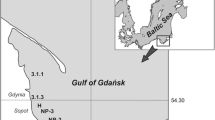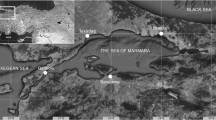Abstract
The mussel Anodontites trapesialis (Lam, 1819) was used as an indicator of organochlorine pollutants in the Pardo River, located in the municipality of Ribeirão Preto (21° 07′S and 47° 45′W), State of São Paulo, Brazil.
Biological monitoring was performed for one year at the site of a sugar cane grove on the left bank of the river. Forty-three animals were placed in two aluminum enclosures on the river bottom at this site and 4 animals of each enclosure were sacrificed for pesticide analysis at 3-month intervals, each collection corresponding to one season of the year.
The animals were found to have been exposed to DDT, lindane, heptachlor, aldrin and dieldrin. Endrin was not detected in any of the analyses.
Similar content being viewed by others
References
Ackerman LB (1980) Overview of human exposure to dieldrin residues in the environment and current trends of residue level in tissue. Pesticide Monit J 14:64–69
Avelar WEP, Nather FC, Figueiredo MCG, Casanova IC, Lopes JLC (1991) Biological monitoring of organochlorides using the liminic bivalve Anodontites trapesialis (Lam. 1819). An Acad bras Ci 63:337–343
Bedford JW, Roelops EW, Zabik MJ (1968) The freshwater mussel as biological monitor of pesticide concentrations in a lotic environment. Limn and Ocean 13:118–126
Borylawskyj M, Garrod A (1987) Mussels measure more pollutants in rivers. New Scientist Aug 29
Butler PA, Kennedy CD, Schutzmann RL (1978) Pesticide residues in estuarine mollusks, 1977 versus 1972—National Pesticide Monitoring Program. Pesticide Monit J 12:99–101
Cáceres O, Tundise JG, Castellan OMA (1980) Resíduos de inseticidas organoclorados na represa do Broa e seus tributários. Ciênc Cult 32:1659–1662
Cáceres O, Castellan OMA, Moraes G, Pereira M (1981) Resíduos de pesticidas clorados em água das cidades de São Carlos e Araraquara. Ciênc Cult 33:1622–1626
Cáceres O, Tundise JG, Castellan OMA (1987) Residues of organochloric pesticides reservoir in São Paulo State. Ciênc Cult 39:259–264
Celeste MF, Cáceres O (1987) Resíduos de praguicidas clorados na represa do Ribeirão do Lobo (Broa) e nos seus tributários. Ciênc Cult 39:66–70
Costa Neto PLO (1977) Estatística, 3rd ed. Editora Edgard Blücher, São Paulo, 264 pp
Hamelink JL, Waybrant RC (1976) DDE and Lindane in a large scale mode lentic ecosystem. Trans Am Fish Soc 105:124–134
Hashemy-Tankabony SE, Langaroodi FA (1976) Detection and determination of chlorinated pesticide residues in Caspian Sea fish by gas liquid chromatography. Environ Res 12:275–280
Jager KW (1970) Aldrin, dieldrin, endrin and telodrin—An epidemiological and toxicological study of long term occupational exposure. Elsevier, Amsterdam, 234 pp
Lara WH, Barreto HHC (1972) Resíduos de pesticidas clorados em água. Revta Inst Adolfo Lutz 32:69–74
Lara WH, Barreto HHC, Inomata ONK (1985) Níveis de BHC e DDT em peixes camarões e ostras do litoral de Santos, Estado de São Paulo. Síntese 8:3–7
Leard RL, Grantham BJ, Pessoney GF (1980) Use of selected freshwater bivalves for monitoring organochlorine pesticide residuos in Major Mississippi stream systems, 1972–1973. Pesticide Monit J 4:47–52
Lenardon AM, Hevia MJM, Fuse JA, Nochetto CB, Depetris PJ (1984) Organochlorine and organophosphorus pesticides in the Paraná river (Argentina). Sci Total Environ 34:289–297
Matuo YK (1978) DDT levels in maternal milk in the Ribeirão Preto region. Master's thesis, Nursing School of Ribeirão Preto. U.S.P. 71 pp
Matuo YK, Lopes JNC, Casanova IC, Matuo T, Lopes JLC (1992) Organochlorine pesticide residues in human milk in the Ribeirão Preto region, State of São Paulo, Brazil. Arch Environ Contam Toxicol 22:167–175
Olafson RW (1978) Effect of agricultural activity on levels of organochlorine pesticides in hard corals, fish and moluscs from the Great Barrier Reef. Mar Environ Res 1:87–108
Pfeifer GY, Ponyi JE, Nagy Z (1979) Pesticide residues in Lake Balaton. Symp Biol Hung 19:21–26
Polemio M, Bupo SA, Provenzano MR (1983) Chlorinated hydrocarbon pesticide residues in irrigation waters. Environ Technol Lett 4:189–194
Richard JJ, Junk GA, Avery MJ, Nehring NL, Fritz JS, Svec HJ (1974) Analysis of various low waters for selected pesticides: atrazine DDE and dieldrin—1974. Pesticide Monit J 9:117–123
Rocha AA, Fukuda F, Costa JR (1973) Poluição por pesticidas no sudeste de Goiás. VII Congresso Brasileiro de Engenharia Sanitária. Salvador, Bahia, São Paulo - CETESB: 1–21
— (1974) Aspectos ecológicos e aplicação de pesticidas na cotonicultura do sudoeste de Goiás, Brasil. XIV Congresso Interamericano de Engenharia Sanitária, México, São Paulo - CETESB: 1–38
Sumner CE (1978) Chlorinated hydrocarbon pesticide residues in Pacific oysters (Crassostrea gigas) from Tasmania, Australia. Pesticide Monit J 12:87–90
Tommasi LR (1985) Pesticide residues in water and sediments of the estuarine system of Santos (São Paulo), (Brasil). Ciênc Cult 37:1001–1012
Author information
Authors and Affiliations
Additional information
Research supported by “Conselho Nacional de Desenvolvimento Científico e Tecnológico” (CNPq) and by “Fundação de Amparo à Pesquisa do Estado de São Paulo” (FAPESP).
Rights and permissions
About this article
Cite this article
Lopes, J.L.C., Casanova, I.C., de Figueireido, M.C.G. et al. Anodontites trapesialis: A biological monitor of organochlorine pesticides. Arch. Environ. Contam. Toxicol. 23, 351–354 (1992). https://doi.org/10.1007/BF00216244
Received:
Revised:
Issue Date:
DOI: https://doi.org/10.1007/BF00216244




